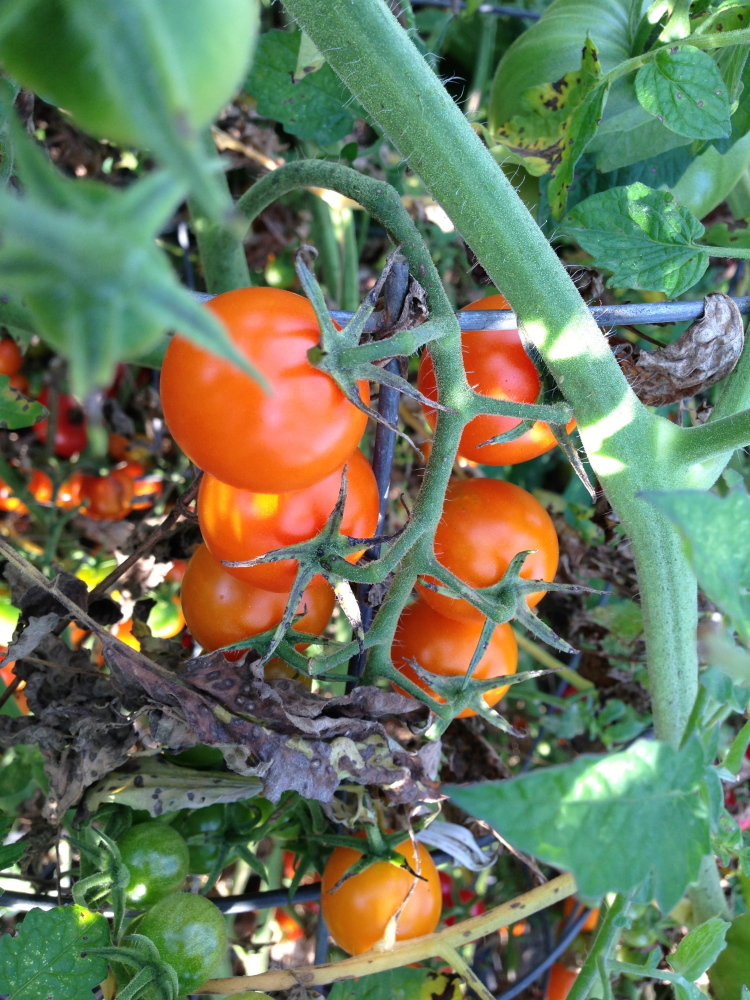I knew I’d failed at tomatoes this summer.
At home, I’ve got one under-watered, malnourished potted Sun Gold plant yielding only a couple orange cherry tomatoes a week for my 3-year-old Theo to pick. The backyard garden is mostly too shady for tomatoes, but next year I might try EarthBoxes, as I covet the trellised ones teaming with hundreds of sweet Sun Golds and Red Roses on the waterfront porch of a neighbor of my parents in Belgrade Lakes.
I’ve also got a tangle of weedy volunteers that came up where many Matt’s Wild Cherries fell and rotted on the ground of my community garden plot last summer – and those are yielding some hidden fruit.
As a farm groupie, I’ve learned so much about tomatoes. I know about all the heirloom and new indigo-skinned varieties, how farmers are grafting more fragile, tasty ones onto hardier rootstock. Still, my own garden suggests little of this absorbed knowledge has materialized into tangible fruit.
(Happily, there’s one exception – a tomatillo plant that toppled over, its sprawling branches jammed with the husked fruits; I plan to cook them down into my father’s famous Mexican salsa verde; watch for the recipe in next week’s column.)
So though I again failed to realize my garden ideals, my son still experiences the thrill of picking his own sun-warmed garden tomatoes at Crystal Spring Farm in Brunswick, where we have a CSA share. They planted a caterpillar jungle tunnel of 6-foot-tall tomatoes for customers to pick, and Theo loves foraging there.
For cooking down or roasting into sauce to get you through the winter, Crystal Spring and others (Whatley Farm in Topsham, for one) sell discounted tomato seconds that we plan to load up on, once we can wrap our heads around canning tomatoes.
Realistically, that won’t happen until late next month. We are waiting for the weather to cool, the school routine to return and for life generally to slow down. That’s when I hope to gather some mom friends together to peel and hot-pack the tomatoes in one of our kitchens, sharing the labor – and the results.
It’s always better to put food by together.
For now, though, we mostly subsist on summer’s ripe tomatoes raw. When in doubt, I slice them up and toss them with a drizzle of cold-pressed olive oil, minced garden garlic, slivered basil, crunchy Maldon sea salt and a couple grindings of black pepper.
Coarsely chop those tomatoes, add more garlic and basil, a bigger glug of fruity olive oil, and salt and pepper, and let the mixture marinate all day at room temperature, and it will exude the most exquisite juice. I gleaned this brilliant “Raw Tomato Sauce for Pasta” technique from New York food critic Gael Greene, that sybaritic sensualist. It’s a surprisingly chaste and cleansing recipe from her memoir, “Insatiable: Tales from a Life of Delicious Excess.” Apparently, when Greene gave the uncooked sauce idea to the New York Times’ Craig Claiborne, he first thought it was awful – the approach works only with summer’s most flavorful, juicy tomatoes.
Then there’s gazpacho and salsa. Eventually though, everyone tires of raw tomatoes, no matter how juicy and flavorful. When you do, make this fish baked in a fresh tomato sauce, with the hot chiles, garlic and cilantro that are now abundant at Maine farms. It’s also the perfect vehicle for the state’s sustainable (and cheap), neglected “trash” fish. I made it with local hake from Hannaford; pollock, Acadian redfish, haddock, local dogfish, herring, mackerel or swordfish would all be delicious, too.
Fish is an appealing, healthful change from a summer of excess. We’ve let Theo eat too many hot dogs and French fries, too much ice cream and pizza. Sadly, we’re eating less fish ever since Portland’s Salt + Sea halted its weekly deliveries of fresh fillets until spring 2015; the owner, Justine Simon, is on maternity leave.
Thankfully, eying the splitting tomatoes, peppers and flowering cilantro stems from our CSA share, I remembered this revelatory dish prepared years ago by my sister-in-law Julia Stone. After graduating from college with a Middle Eastern studies degree, she had just returned from a year working in a Bedouin-settled beach haven on Egypt’s Sinai Peninsula, where she ate Red Sea fish at least thrice weekly, often prepared in a similarly spiced tomato sauce, or grilled alongside pita and ful (mashed fava beans) for a traditional breakfast.
Julia’s first Egyptian tomato evoked the same delight her mother had described when she encountered tomatoes on her honeymoon to Italy 40 years ago. “The texture was not the least bit mealy. The tomato smallish and deep red inside and out – and bursting with a kind of warm, almost umami-like sweetness to make you want another bite.”
Moreover, there’s something universal about seafood in a garlicky, spicy tomato sauce. Bowls of shells piled high above a mess of spaghetti used to be my husband Dan’s favorite meal, until he developed a mild shellfish allergy. Still, for his 35th birthday recently, his only request was that we finally make the pilgrimage to cash-only Conte’s 1894. Eager diners line up every night outside the crumbling Rockland shack, with its “Sold Out! Sorry Closed” sign posted nightly about 7:30 p.m., made famous when featured on Anthony Bourdain’s “No Reservations” show.
It’s worth trying Conte’s imported San Marzano-sauced seafood dishes, and the complimentary huge house salad with pale, knife-requiring hard red wedges (decidedly not ripe heirlooms), somehow more appropriate for the viscous balsamic vinaigrette. You’ll be reminded just how far we Americans – and Italians – have come in our love affair with the humble Andean tomato. Virile, if famously temperamental, John Conte, with belly and gray-haired chest and varicose-veined strong calves exposed, consistently churns out deep glass pie plates of red sauces, crowned with split Maine lobsters, and ultra-fresh (the restaurant lacks a freezer) Georges Bank haddock, swordfish, scallops and clams.
“You should write a guide to ‘The Quirky Italian Restaurants of the World,'” suggested an Australian couple from London we’d chatted up in line for our meal.
The London couple suggested the Italian-inspired teahouse at Petersham Nurseries, much more our local and seasonal style. Conte’s would still make the cut, as well as Mama Zu’s, with its raucous, rushed and rude service. It’s a family-style Italian joint and our favorite restaurant in my hometown of Richmond, Va. (It’s in the running for our favorite anywhere.) That’s because comfort-food red sauces have staying power. And the credit, of course, ultimately goes to that beloved ,ubiquitous fruit masquerading as a vegetable: the tomato.
BAKED FISH IN CHILI-CILANTRO SAUCE
This recipe is adapted from Faye Levy’s 2003 cookbook “Feast from the Mideast: 250 Sun-Drenched Dishes from the Lands of the Bible.” To vary the recipe, she recommends incorporating fresh dill or other green herbs; a pinch of saffron, fresh or ground ginger and turmeric are also natural here. I enhanced the tomato puree with a red bell pepper, a carrot and extra garlic, whirred together in my Vitamix. For the fish, I used Maine hake, or try Acadian redfish, pollock, dogfish or haddock. Serve, with rice, pearl (or Israeli) couscous, orzo, or flatbread, and garnish with cilantro sprigs.
Makes 4 servings
1½ pounds cod, halibut or other firm, lean fish, about 1-inch thick, cut in 4 pieces, rinsed and patted dry
1 tablespoon freshly squeezed lemon juice
3 tablespoons chopped cilantro
3 tablespoons olive or vegetable oil
Salt and freshly ground pepper, to taste
1 medium onion, chopped
2 to 3 fresh ripe plum tomatoes
1 mild green chili, such as Anaheim or poblano, cored, seeded and diced
2 jalapeño peppers, minced
2 large garlic cloves, minced
1 teaspoon ground coriander (or fresh green coriander from your garden cilantro gone to seed)
½ teaspoon ground cumin
Cilantro sprigs, for garnish
Put the fish pieces on a tray in a single layer. Mix the lemon juice with 1 tablespoon cilantro, 1 tablespoon oil and a pinch of salt and pepper. Pour the mixture over the fish and turn to coat both sides. Let stand while preparing the sauce.
Preheat the oven to 400 F. Heat the remaining 2 tablespoons oil in a skillet. Add the onion and cook over medium-low heat, about 5 minutes, until soft but not brown.
Meanwhile, puree the tomatoes in a blender or food processor; set aside.
Add the chilies and garlic to the onions and cook for 1 minute. Stir in the coriander, cumin and pureed tomatoes and cook for 2 minutes. Stir in ⅓ cup water and bring to a simmer. Add the remaining 2 tablespoons cilantro (and extra stems if you like for extra flavor). Taste and adjust seasoning.
Lightly oil a baking dish large enough to hold the fish in a single layer. Spoon about one third of the sauce into the dish. Top with the fish and sprinkle lightly with salt and pepper. Top with the remaining sauce. Cover the baking dish and bake for 18 to 20 minutes, or just until the fish can be flaked with a fork in its thickest part.
Send questions/comments to the editors.




Success. Please wait for the page to reload. If the page does not reload within 5 seconds, please refresh the page.
Enter your email and password to access comments.
Hi, to comment on stories you must . This profile is in addition to your subscription and website login.
Already have a commenting profile? .
Invalid username/password.
Please check your email to confirm and complete your registration.
Only subscribers are eligible to post comments. Please subscribe or login first for digital access. Here’s why.
Use the form below to reset your password. When you've submitted your account email, we will send an email with a reset code.